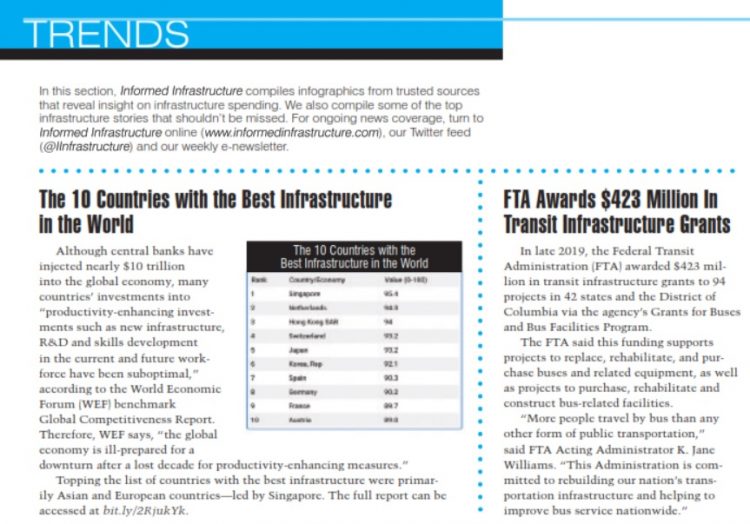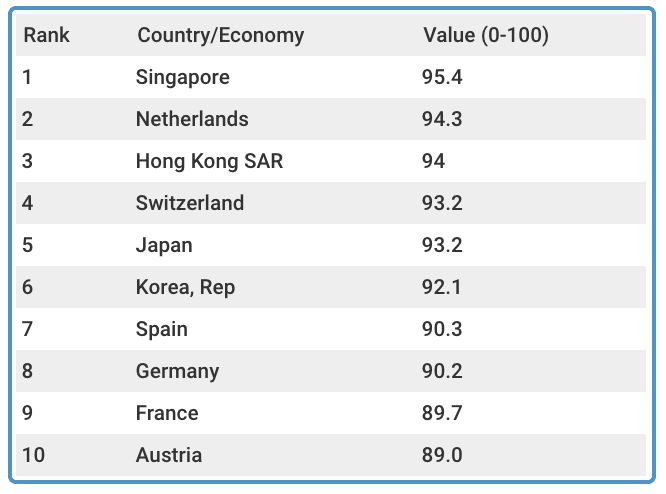February 2020 Trends

The 10 Countries with the Best Infrastructure in the World
Although central banks have injected nearly $10 trillion into the global economy, many countries’ investments into “productivity-enhancing investments such as new infrastructure, R&D and skills development in the current and future workforce have been suboptimal,” according to the World Economic Forum (WEF) benchmark Global Competitiveness Report. Therefore, WEF says, “the global economy is ill-prepared for a downturn after a lost decade for productivity-enhancing measures.”
Topping the list of countries with the best infrastructure were primarily Asian and European countries—led by Singapore. The full report can be accessed at bit.ly/2RjukYk.

FTA Awards $423 Million In Transit Infrastructure Grants
In late 2019, the Federal Transit Administration (FTA) awarded $423 million in transit infrastructure grants to 94 projects in 42 states and the District of Columbia via the agency’s Grants for Buses and Bus Facilities Program.
The FTA said this funding supports projects to replace, rehabilitate, and purchase buses and related equipment, as well as projects to purchase, rehabilitate and construct bus-related facilities.
“More people travel by bus than any other form of public transportation,” said FTA Acting Administrator K. Jane Williams. “This Administration is committed to rebuilding our nation’s transportation infrastructure and helping to improve bus service nationwide.”
TOP Stories
The following are the top stories from the last few months (in terms of traffic) on the Informed Infrastructure website. This also reflects key coverage areas that are regularly refreshed online and via our weekly e-newsletter. Simply search key words on Informed Infrastructure online to find the full story.
Buildings
• Video: Secrets of the Parthenon
• DeSimone Designs World’s First Guitar-Shaped Hotel
• AISI and CCFSS Announce the Publication of “Cold-Formed Steel Design – Fifth Edition”
• DFI Publishes New White Paper on Crosshole Sonic Logging (CSL) Available for Free
Water
• New ASCE Report Offers Guidance for Stormwater Control Measures
• Microbes for Hire: Snapshots of Bionetix Natural Wastewater Solutions Around the Globe
• WaterStart and KETOS Partner to Address Las Vegas Water Challenges
• Skokie Engages New Technology to Evaluate Water Main Infrastructure
Transportation
• Video: Science to Reveal How Long Highway Construction Should Actually Take
• U.S. Department of Transportation Announces
$75 Million for Tempe Streetcar Project
• Engineers Mull Cause of Bridge Collapse
Tools and Technology
• Bentley Systems Accelerates Focus on Infrastructure Engineering for Digital Cities
• Video: Ford’s Don Butler Focuses on Future of Vehicle-to-Vehicle Connectivity
• New Trimble R12 Receiver Boosts Surveying Performance
• Cesium Takes City Visualizations Into the 3rd Dimension Through Open-Source Collaboration
Forecast Season Is Here
A new year always brings a new crop of forecasts, reports and predictions for the coming year. This subsection summarizes a few of the reports that recently came out concerning the infrastructure markets.
Real Growth for 2020 Transportation Construction Market
The U.S. transportation infrastructure market is expected to grow at least 5 percent in 2020, according to the annual economic forecast released by the American Road & Transportation Builders Association (ARTBA).
“The real market growth for 2020 is being fueled by increased transportation investments from federal, state and local governments,” said ARTBA Chief Economist Dr. Alison Premo Black, who conducted the analysis.
Total domestic transportation construction and related-market activity in 2020 should reach $300.4 billion, up from 2019’s $286.5 billion, after adjusting for project costs and inflation.
The transportation construction market grew by 8 percent in 2019 compared to 2018, driven largely by gains in highway, street and pavement work, which grew by $9.6 billion to $73.1 billion.
ARTBA’s forecast is based on a series of proprietary econometric models for each mode as well as analysis of federal, state and local data and market intelligence. The full forecast can be purchased at www.artbastore.org.
Global Spending in Construction to Reach $17.5 Trillion by 2030
According to Frost & Sullivan’s recent analysis, “Future of Construction, Global, 2030,” the construction industry is in the middle of a transition toward new business models that are technology- and data-driven, better collaboration among stakeholders, and higher productivity. The increasingly aging workforce and digitization are prompting greater investments in workforce management and digital solutions.
By 2030, global spending in construction is expected to touch $17.5 trillion, with China, the United States and India leading the way and accounting for 57 percent of all global growth. More than 60 percent of the global infrastructure investment will be in emerging economies, particularly Asia, while the United States and Canada will contribute almost 20 percent.
“Technological advancements in Artificial Intelligence (AI), cloud software, drones, and pre-fab construction will be leveraged to reduce cost and improve quality and speed of construction,” said Chaitanya Habib, Visionary Innovation Research Consultant at Frost & Sullivan. “Smart infrastructure technologies embedded with telematics, too, will influence the future of the industry by creating an intelligent and on-demand system that reduces operational costs and augments productivity.”
“Future of Construction, Global, 2030” is part of Frost & Sullivan’s global Visionary Innovation (Mega Trends) Growth Partnership Service program, which can be accessed at bit.ly/36iZSlp.
Multi-Trillion Dollar Market for Climate Restoration Through Carbon-Capture
Thunderbird School of Global Management released a new report projecting that the world can realize at least $1 trillion – $3 trillion in market opportunities and $3 trillion – $5 trillion in broader economic, social and environmental benefits per year by 2030.
Thunderbird’s Director-General and Dean, Dr. Sanjeev Khagram, authored the new report and shared it at a cross-sectoral gathering hosted by Thunderbird with the Foundation for Climate Restoration in Davos, Switzerland, during the World Economic Forum’s 2020 annual meeting.
“Together, we must rapidly deploy natural and technological solutions to remove gigatons of carbon dioxide from our air, restore ocean ecosystems, and preserve Arctic ice, while dramatically reducing emissions and adapting to climate change impacts,” said Dr. Khagram. “Climate restoration is the critical third pillar of climate action alongside climate mitigation and adaptation.”
Find the full report at bit.ly/36ebvKk.
U.S. Transportation Infrastructure Growth to Mirror Slower GDP in 2020
U.S. transportation infrastructure growth will continue moving more or less in step with levelling-off GDP, according to Fitch Ratings’ “2020 Outlook: U.S. Transportation Infrastructure” report.
Volume growth remains favorable for U.S. airports, ports and toll roads, and will remain largely tethered to U.S. GDP movement, which Fitch projects will fall below 2 percent for 2020. That said, “some softness in growth may take hold to the extent issuers are exposed to global economic markets and protectionist trade policies,” said Senior Director Scott Zuchorski.
Likely to pace volume growth will be U.S. airports, with Fitch projecting 2-3 percent thanks to continued healthy demand for travel. Passenger traffic also will remain healthy for both large- and small-hub airports following a spike in 2019.
The full report is available at www.fitchratings.com.


